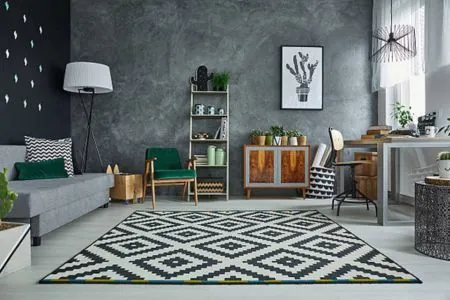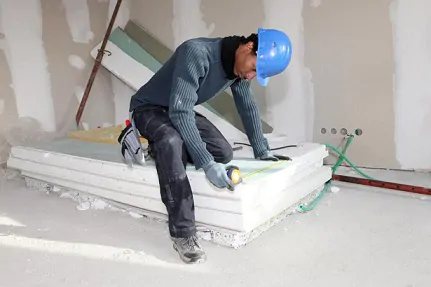
Interior Stucco Walls: Benefits, Styles, and Design Inspiration
Interior stucco walls provide a unique blend of aesthetic appeal, durability, and versatility that can transform your home. With moisture resistance and various finishes—from smooth
Looking for top-quality drywall installation services in Santa Fe, NM? Look no further! Our expert team has years of experience in the industry, ensuring a seamless and professional finish for your project. Call us today!

Drywall installation and repair is available to help improve the condition of your indoor walls, maintain their appearance and integrity if they have become damaged, as well as increase the aesthetic of your interior walls. Drywall is easy to paint, install, and requires little to no maintenance over time. It is also relatively inexpensive, meaning that you won’t have to spend a fortune for interior wall solutions either.
Drywall installation is a quick process that doesn’t require many tools but it does require manpower. This is because, one must hoist the heavy drywall sheets into the frames and secure them in place. Once this is completed, the edges of the drywall can be sealed and taped, therefore reducing the appearance of the creases between drywall panels or boards. Drywall installation also requires measuring, removing, and lifting larger items which – for your own safety – should be done by a team of professionals to avoid injury.
Drywall repairs are very easy to complete as they typically only require using a stucco contractor to fill the cracks and holes that have appeared in the drywall. If, for example, you hung a picture on a drywall and no longer want the nail holes in the wall, we would use a drywall filling paste, known as spackle, to fill the hole, crack, or scratch. While drywall can become damaged with blunt force, it doesn’t need to stay damaged or cost a lot to replace drywall. Spackle helps provide a solution to repairing and evening out your drywall so that you don’t find yourself needing a brand new drywall altogether and it can also prolong your drywall interiors as a whole for ongoing use.
The main use for interior drywall is to fill and cover the frames of walls and ceilings. Drywall serves as a wall solution that’s sturdy, firm, and durable for interior use. Drywall is composed of a dense, flat composite that lacks a lot of texture which makes it easier to paint or put vinyl and wallpaper on. If you’re looking for a great base material to install into your home and later customize with colorful designs or adhesives, then we highly recommend drywall for such a project. Drywall, once installed, doesn’t require much maintenance aside from minor repairs.
Once your drywall has been installed and taped, you can then begin to paint it. We recommend having your drywall panels taped before painting to avoid the crevices accumulating paint or affecting an even layer of paint. For drywall, most interior paints can be used, whether they’re matte, semi-gloss, or satin. If you need assistance with choosing the right paint or primer for your drywall, we can recommend a few that we trust for all of our similar projects. To ensure that your drywall has lasting results, we recommend adding a few layers of easy-to-clean paint that doesn’t show wear and tear over time, fading, or isn’t susceptible to easy staining.
If you’re interested in learning more about our services, we welcome you to contact us directly using the number that we’ve provided. We’re able to assist in answering any questions you may have, scheduling an appointment for a future stucco and plastering service, or simply providing more insight into the products we use and the type of projects we can take on.
Drywall installation requires essential tools like a utility knife, T-square, measuring tape, drywall saw, screw gun, joint compound, taping knives, sanding sponge, and drywall lift for ceiling work. Additionally, corner beads, joint tape, and a drill with drywall screws are necessary for securing the panels. Professionals may also use automatic taping tools to speed up the finishing process. Having the right tools ensures precise cuts, secure installation, and a smooth final surface.
Standard drywall thickness varies based on application. For interior walls, 1/2-inch drywall is the most common, offering a good balance between durability and weight. For ceilings, 5/8-inch drywall is preferred as it reduces sagging and provides better fire resistance. In areas requiring extra soundproofing or moisture resistance, specialized drywall like 3/4-inch soundproof or moisture-resistant panels may be used. Choosing the correct thickness ensures structural integrity and long-term performance.
Yes, drywall can be installed over existing walls, including plaster or old drywall. This method is often used to refresh outdated surfaces or improve insulation. The process involves securing the new drywall with screws or adhesive while ensuring a level surface. However, it may slightly reduce room space due to the added thickness. Properly preparing the existing wall, such as removing loose materials, ensures a strong, smooth installation.
Drywall is secured using drywall screws or nails fastened into wall studs or ceiling joists. Screws provide better holding strength and reduce the risk of nail pops. Adhesive may also be used for additional bonding. Proper spacing—typically 16 inches between studs—ensures stability. For ceilings, a drywall lift can help hold panels in place during installation. Correct fastening techniques prevent sagging, cracking, and future repairs, ensuring long-term durability.
While insulation isn’t always required behind drywall, it improves energy efficiency, soundproofing, and comfort. Fiberglass batts, spray foam, or rigid foam insulation can be installed within wall cavities before drywall installation. In exterior walls and basements, insulation helps regulate indoor temperatures and prevent moisture issues. For interior walls, soundproof insulation can enhance privacy. Properly insulating before drywalling enhances overall home efficiency and reduces heating and cooling costs.
To prevent drywall cracks, ensure proper installation by securing panels tightly to studs and avoiding excessive joint gaps. Using high-quality joint compound and tape reinforces seams. Allowing sufficient drying time between coats reduces shrinkage cracks. In high-moisture areas, moisture-resistant drywall prevents expansion-related cracking. If cracks appear, they can be repaired with fresh compound and sanding. Preventative measures help maintain a flawless, long-lasting drywall finish.
Yes, drywall can be installed in basements, but moisture control is essential. Mold-resistant drywall (purple or green board) is recommended to prevent water damage. A vapor barrier and proper insulation help keep moisture out. If the basement is prone to flooding, alternative wall materials like cement board or waterproof panels may be better options. Installing drywall correctly in a basement enhances the space while preventing long-term water-related issues.
Yes, drywall is commonly installed on ceilings, using thicker panels (5/8-inch) to prevent sagging. A drywall lift can assist in holding panels while fastening them with screws to ceiling joists. Proper spacing and support ensure durability. Texturing or finishing options can further enhance the appearance.
Fire-rated drywall (Type X) contains special additives to improve fire resistance, making it ideal for garages, basements, and commercial buildings. It slows fire spread, providing extra safety.

Interior stucco walls provide a unique blend of aesthetic appeal, durability, and versatility that can transform your home. With moisture resistance and various finishes—from smooth

Walls do more than divide rooms; they set the mood and style of your home. If you are looking for a way to add depth,

When it comes to home improvement projects, drywall installation is a common task that often raises questions about costs. Whether you are building a new
Stucco Contractors Santa Fe has been serving the Santa Fe area with quality stucco and plastering services for many years and continues to do so with the same standard of service that we always have.
© 2025 Stucco Contractors Santa Fe NM All rights reserved